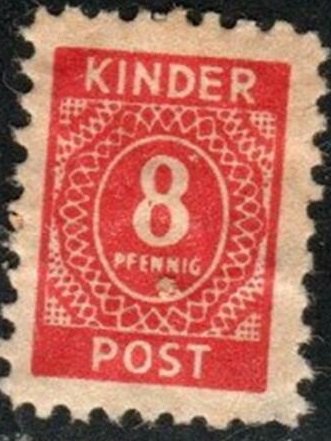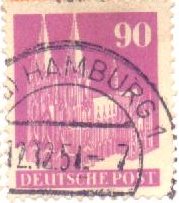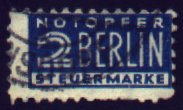 |
|||||
|
|||||
| Preview of Stamps Catalogue: VOLUME 1 |
 |
|||||
|
|||||
| Preview of Stamps Catalogue: VOLUME 1 |
Return To Catalogue - Germany, 1945 French Occupation Zone
Note: on my website many of the
pictures can not be seen! They are of course present in the catalogue;
contact me if you want to purchase it.
After the end of World War II, the American and British occupational zones were joined to form the so-called Bizone. The Russian and French zones issued their own stamps.
The following values were issued: 1 p black 3 p violet 4 p grey 5 p green 6 p yellow 8 p orange 10 p brown 12 p lilac 15 p red 16 p green 20 p light blue 24 p brown 25 p blue Slightly larger size: 30 p green 40 p lilac 42 p green 50 p green 60 p brown 80 p blue Even larger size 1 M green
Specialists distinguish three types of these
stamps (not all stamps were issued in all types); American
(Washington) printing, British (London) printing and German
(Brunswick) printing. There is a white triangle in the ornament
left to the "P" of "PFENNIG" in the German
printing and the perforation is 11, 11 1/2 or compound. The
London printing has much narrower perforation 14 1/4, 14 3/4 and
compound. The American printing has perforation 11 and there is
no white 'patch' in the spandrel next to the "P" of
"PFENNIG".
In the American printing were issued the values 3 p, 4 p, 5 p, 6
p, 8 p, 10 p, 12 p, 15 p and 25 p. In the British printing were
issued the values 3 p, 4 p, 5 p, 6 p, 8 p and 12 p. In the German
printing all values were issued.

Distinghuishing characteristic of the German print, there is a
white triangle in the ornament just left to the upper part of the
'P'.



American, German and British printing of the 6 p stamp
Stamps with overprint "Military Permit Office Fiscal Stamp" and bar on "AM POST" are fiscal stamps used for American soldiers issued in 1947. Two values exists $1 on 8 p orange and $2 on 12 p lilac.
The printer and stamp forger Otto Thobe (Duisburg? Germany) made forgeries of the values 8 p, 80 p and 1 M (all German printing type). Often referred to as postal forgeries (for example in 'The Postal Forgeries of the World' by H.G.L.Fletcher), I think they were actually forgeries to deceive collectors. He also made letters with these forgeries, combined with genuine stamps and applied a forged registration label and a forged cancel 'Hannover 4 14 7 45'. More information on these forgeries and this forger can be found in 'Fakes & Forgeries of Germany & Colonies No.2' by The German Philatelic Society Inc, page 48. I'll give the distinguishing characteristics as they appear in these books. The colour of the forged 8 p is dull red orange, while the genuine 8 p stamp is deep orange in colour. The white triangle to the left of the "P" of "PFENNIG" has been reduced to almost a dot. The word "AM" is smaller than "POST". In the forged 80 p stamp there is a dot in the white line just above the "T" of "DEUTSCHLAND". The forged 1 M stamp is very deceptive, the lines are 'shaky' and the two "1"s are narrower than in the genuine stamp. Since this stamp was photo-lithographed, the design is quite accurate but a little blur. The ornaments in the left lower part tend towards being fully coloured.

Thobe forgery of the 1 M stamp; there is a blotch of green color
in the white vertical line to the left of "RE" of the
right hand side "REICHSMARK"

Left so-called 'Thobe' forgery of the 80 p stamp, right genuine
80 p stamp; in the forgery, there is a dot in the white line just
above the "T" of "DEUTSCHLAND", reduced size.
Also, the "A" of "DEUTSCHLAND" does not have
a triangle inside it (it is all blank).
Thobe also made a forgery of the Africa Corps Tunis stamp.
The forger Peter Winter made forgeries of the 8 pf (sheetlet of 2 stamps, tete-beche, perforation 11 1/2 x 11 or imperforate) and the 80 pf (sheetlets of 3x3 stamps, perforation 11 x 11 1/2 or imperforate). I do not know the distinguishing characteristics of these forgeries, they were made in the 1980's.
I've also seen forgeries of the 80 p value with the word "FAUX" printed below the right hand bottom corner.

80 c forgeries with "FAUX" written at the bottom right.

1 p black 2 p black 3 p brown 4 p blue 5 p green 6 p violet 8 p red 10 p brown 12 p red 12 p grey 15 p red 15 p green 16 p dark green 20 p light blue 24 p light brown 25 p blue 25 p yellow 30 p olive 40 p lilac 42 p 45 p red 50 p green 60 p red 75 p blue 80 p dark blue 84 p green 1 M olive (larger size)
I've seen postal stationary of the 12 p grey ('Postkarte').
These stamps exist with posthorn overprints in two types: in a band or on the whole stamp ('Band' and 'Netz' in German).

I've seen a minisheet, containing a 20 p, a 40 p and a 24 p stamp, with additional inscription 'FUNF REICHSMARK FUR FLUCHTLINGS - UND ALTERSHILFE'. This sheet was issued for charity purposes. I've seen the stamp in this sheet both perforated and imperforate. This mini-sheet was reprinted for the 1.Nationale Briefmarken- messe PHILATELIA Berlin Alexanderplatz 8./10.11.1990 (this text is included at the left and right hand side).

Forged minisheet with "copy" written at the bottom of
each stamp.
The 45 p exists with overprint '5 BERLIN' to be used in Berlin.

A local overprint for Frankenberg: click
here for more information.

Overprinted "BERLIN" and surcharged, to be used in
Berlin


"KINDER POST" in the same design; toy stamps

Inscription '1947' 12 p red 24 + 26 p brown 60 + 40 p blue 75 p blue Inscription '1948' 50 p blue 84 p green
Similar stamps were issued for East Germany, but with inscription "DEUTSCHE DEMOKRATISCHE REPUBLIIK LEIPZIGER MESSE 1950".
Planting trees 2 p black 6 p violet 15 p brown 25 p yellow Sowing 8 p red 10 p green 20 p blue 40 p lilac Man 12 p grey 30 p red 60 p red (specialists distinguish two shades of colour) 80 p blue Family at work 16 p green 24 p light brown 50 p blue 84 p green Chained hands releasing dove of peace (larger size) 1 M light green 2 M violet 3 M red 5 M blue
These stamps exist with posthorn overprints in two types: in a band or on the whole stamp ('Band' and 'Netz' in German).



These stamps also received the overprint 'BERLIN' to be used in
Berlin. Also the 24 p exists with '10 BERLIN' overprint, the 80 p
with '20 BERLIN' overprint and the 3 M with '1 BERLIN' overprint.

With overprint 'Sowjetische Besatzungs Zone' for the Russian
occupation zone
24 p brown 75 p blue
24 p brown 75 p blue





2 p black (Frankfurt) 4 p light brown (Munich church) 5 p blue (Cologne cathedral) 6 p brown (Munich church) 6 p orange (Munich church) 8 p orange (Frankfurt) 8 p dark blue (Munich church) 10 p green (Cologne cathedral) 15 p violet (Frankfurt) 15 p orange (Munich church) 16 p light blue (Frankfurt) 20 p red (Berlin monument) 20 p blue (Frankfurt) 24 p red (Berlin monument) 25 p red (Cologne cathedral) 30 p blue (Berlin monument) 30 p red (Munich church) 40 p lilac (Cologne cathedral) 50 p blue (Berlin monument) 50 p light blue (Munich church) 60 p brown (Cologne cathedral) 80 p lilac (Berlin monument) 84 p lilac (Munich church) 90 p lilac (Cologne cathedral) Larger size (all with Lubeck gate design) 1 M green 2 M violet 3 M lilac 5 M blue
Many different kinds of perforations exist.
Imperforate stamps of the values 25 p, 40 p, 60 p and 90 p originate from stolen printers waste. Some patially perforated stamps originate from the same source. A few sheets of imperforate 10 p stamps were sold in a postoffice in Hessen at the beginning of 1949. More information can be found in 'Fakes & Forgeries of Germany & Colonies No.2' by The German Philatelic Society, page 114-118.
Postal stationary: I've seen a 10 p green postcard with an image of the Lubeck gate (Mark design, however smaller size):

Some 'reprints' made for the Philatelia '81 exhibition in
Frankfurt/Main with four 25 p stamps in different colors in the
Frankfurt design with inscription 'PHILATELIA '81' (reduced
size). I've also seen a similar but larger sheet with 10 blue 25
p stamps (with 'PHILATELIA '81' inscription) and 10 orange
'BOREK' advertisement labels. (3 different types)
6 + 4 p light brown 12 + 6 p light blue 24 + 16 p red 50 + 50 p blue (larger size)
10 + 5 p green 20 + 10 p red
10 p green 20 p red 30 p blue
These stamps exist printed in a minisheet containing the three values.

Minisheet with the three values
I've seen 'reprints' of these minisheets. Among them one with imperforate stamps issued for the 'Briefmarkenaustellung Niedersachsischer Briefmarkensammler in Hannover 5-13 Mai 1962' as written at the bottom of the sheet and with text '1947 - 1962 15 JAHRE HANNOVER MESSE' on top.
10 + 5 p green 20 + 10 p red
10 + 5 p green 20 + 10 p red 30 + 15 p grey
'Reprints' were made for the 'Philatelia '81' exhibition. They were printed (all three) on a minisheet with inscription 'Philatelia '81 1749 1832 FRANKFURT/MAIN 14.-18. NOV. 1981 GEBURTSTADT GOETHES'. They have the text 'Philatelia '81' printed at the bottom of each stamp.


'Reprints'
An airmail label with inscription "DEUTSCHE LUFTPOST PAR AVION" in blue was also issued during this period (1949?).

"NOTOPFER STEUERMARKE BERLIN", Obligatory tax stamp to
help Berlin just after World War II; value: 2 p blue. I've also
seen this label imperforate.

With red overprint "Wohnungbau Abgabe"
This stamp exists with a red overprint "Wohnungbau Abgabe" issued for Wurttemberg.